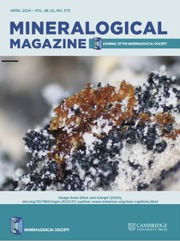Article contents
Mineralogic reaction zones at a calc-silicate/metapelite interface: an example of trace element mobility in a metamorphic environment
Published online by Cambridge University Press: 05 July 2018
Abstract
Metasomatic interaction on a cm scale between calc-silicate pods and the enclosing sillimanite + biotite + tourmaline gneiss at Partridge Breast Lake, northern Manitoba, Canada, led to the development of an inner (by calc-silicate rock), hornblende-rich reaction zone and an outer, biotite-rich zone. The boundary between the reaction zones is interpreted as the original calc-silicate/metapelite interface. Compared with its metapelitic protolith, the biotite zone shows a two- to twenty-fold depletion in the concentrations of incompatible trace elements (notably the light rare earths, U, Th, Nb, Ta, Zr and Hf). In contrast, the relative concentrations of trace elements remained nearly constant during the mineralogical transformation of the calc-silicate rock to the hornblende zone. The depletion of trace elements in the biotite zone is attributed to the dissolution of accessory phases (e.g. monazite). Although stable at the metamorphic conditions (∼600–650°C at ∼ 4.5 kbar) prevalent during metasomatism, Mg-rich tourmaline is absent in the biotite zone, suggesting that either the pH or composition (e.g. the (Al + Si)/(Ca + Mg + Fe) ratio) of the aqueous fluid phase was inappropriate for the preservation of this mineral.
Information
- Type
- Geochemistry
- Information
- Copyright
- Copyright © The Mineralogical Society of Great Britain and Ireland 1994
References
- 2
- Cited by

